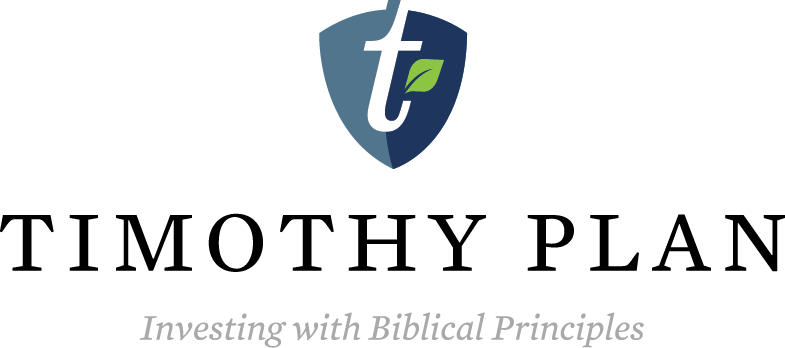International 1Q19
May 8, 2019
Recent Posts
- A Businessman Who Really Did Give it All Over to GodSeptember 28, 2022
- A 'Screwtape' Approach to Keeping Christians from Biblically Responsible InvestingSeptember 21, 2022
- Both Inflation and Inaction Are UnbiblicalSeptember 14, 2022
- Misunderstood in the NeighborhoodAugust 18, 2022
- Billy Graham was the inspiration for the new BiblegraphAugust 9, 2022
- A Businessman Who Really Did Give it All Over to God
Categories

Investing involves risk, including the potential loss of principal.
Before investing, carefully consider the fund’s investment objectives, risks, charges, and expenses of the investment company. This and other important information can be found in the fund’s prospectus. To obtain a copy, visit TIMOTHYPLAN.COM or call 800.846.7526. Read each prospectus carefully before investing.
Because the Timothy Plan Funds do not invest in excluded securities, the Funds may be riskier than other funds that invest in a broader array of securities. There are risks when a fund limits its investments to particular sized companies, and all companies are subject to market risk. The Fund recently experienced significant negative short-term performance due to market volatility associated with the Covid-19 pandemic.
MUTUAL FUND INVESTOR
To read more about our mutual funds, please click this link to access fund information, including the prospectus, fact sheets, performance, and holdings for each fund.A prospectus is available from the Fund or your financial professional that contains more complete, important information. Please read it carefully before investing. Mutual Funds distributed by Timothy Partners, Ltd. Member FINRA.
HEADQUARTERS: 1055 Maitland Center Commons, Maitland, FL
(800) 846-7526 | Send an email | View our mapMUTUAL FUND SHAREHOLDER SERVICES: c/o Ultimus Fund Solutions, Post Office Box 541150, Omaha, NE 68154-1150
(800) 662-0201 | Account AccessETF INVESTOR
To read more about our ETFs, please click this link to access fund information, including fact sheets, performance and holdings for each fund. A prospectus is available from the Fund or your financial professional that contains more complete, important information. Please read it carefully before investing. ETFs distributed by Foreside Fund Services, LLC, Member FINRA. Timothy Partners, Ltd. is not affiliated with Foreside Fund Services, LLC.
ETF SHAREHOLDER SERVICES: Contact your financial advisor for information regarding your account.






Market Backdrop
Global equity markets rebounded strongly for the quarter after a major selloff in Q4 2018. While economic and earnings downgrades continued during Q1, equity markets appeared to be focused on a rebound in activity into the second half of the year. Weak first quarter data appeared to have been priced in the selloff of 2018 while an about face from the world’s two most important central banks provided a stimulus shot to the market. The Federal Reserve and the European Central Bank both retreated from signs of rising rates this year and both went a long way to fight over who was more dovish coming into the second quarter and second half of the year.
With the possibility of the start of green shoots with some data items in Europe and better China economic data arising, markets continue to need confirmation of improving conditions to maintain its current rally. Another set of possible good news could be in the U.S.-China trade negotiations as negotiators from both countries appear to be getting closer to a deal that would remove a major uncertainty for businesses. Commodities rose with oil prices following slower production in OPEC, Venezuela, and Iran and iron ore prices moving sharply higher on supply cuts in Brazil and Australia.
While the New York Federal Reserve’s recession indicator hit a 25% chance of a recession in the U.S., the highest level since the Global Financial Crisis, markets focused on the prospects of looser monetary conditions providing equity markets a boost. The dovish talk from central banks led to a sharp decline in bond yields with the German 10-year bond retreating below zero percent for the first time since 2016 and the U.S. 10-year bond plummeting below 2.5% for the first time since early 2018. The decline in the long bond and lack of a similar move in the front end of the yield curve led to an inverted yield curve at the 3m-10y level which spooked the market. A San Francisco Federal Reserve study from last year indicates an inversion at the 3m-10Y level is the best indicator of a recession one to two years out while other studies suggest the yield curve must remain inverted at least for one quarter for this indicator to work. The markets will be watching this development over the coming months. The lower yields pushed financial sector stocks down, in particular bank stocks, as lower yields and a flatter yield curve makes it much harder for them to earn reasonable rates of returns.
Large caps slightly underperformed small and mid-caps for the quarter while Growth outperformed Value for the quarter. The best performing MSCI EAFE countries for the quarter were New Zealand, Belgium, and Hong Kong while the worst performing MSCI EAFE countries were Singapore, Japan, and Germany. The best performing emerging markets for the quarter were Colombia, China, and Egypt while the worst were Qatar, Turkey, and Poland.
Performance and Attribution
The Timothy Plan International Fund is off to a good start in 2019 as it outperformed the MSCI EAFE index for the quarter. International equities bounced back after a rough finish to 2018 with the Fund increasing double digits for the quarter led by positive stock selection. Stocks in the Industrials and Communications Services sectors performed best for the quarter while an overweight to the Technology sector helped as well. From a country standpoint, Germany, Japan, and Hong Kong stocks performed best relative to the benchmark while any cash weight in a strong market and a void in Switzerland hurt relative performance.
Outlook
After a strong start to the year, we would not be surprised to see volatility rise in the 2nd half of the year as expectations have risen. Investors have shunned European markets to start the year and are very underweight that region and we would expect a strong bounce in those markets if economic activity begins to stabilize and improve there as it appears to be doing so. We have slightly reduced China exposure in the portfolio after a strong run in the 1st quarter as the rhetoric of US-China trade relations is likely to keep this topic in investor’s minds for some time to come. The ECB and BoJ remain very supportive of their respective economies for the remainder of this year providing a tailwind for equity markets.